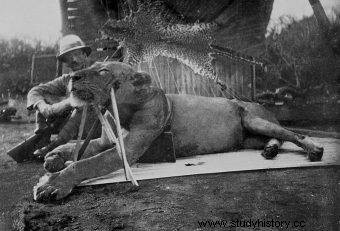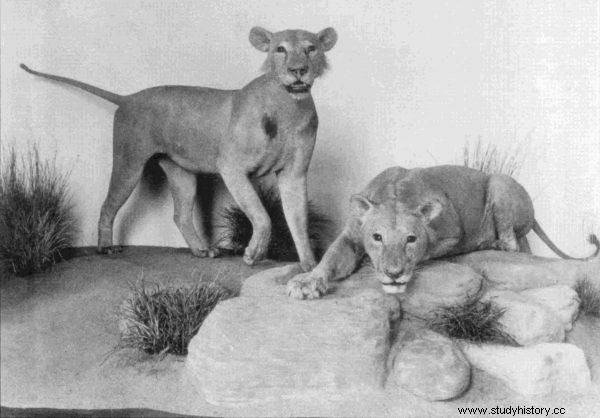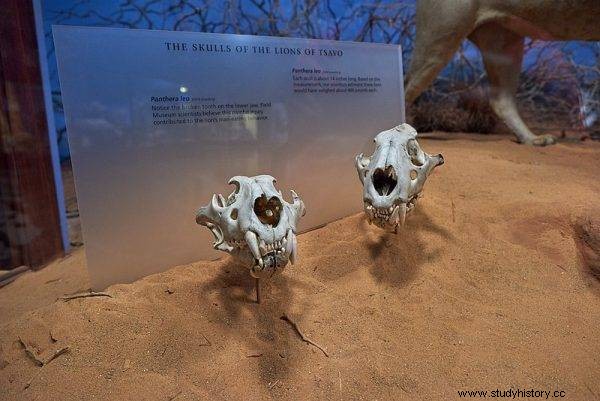They appeared at night, they crossed fences, avoided the barbed wire, they were not afraid of fire. They burst into tents and dragged their victims outside to pierce their bodies with sharp fangs, tear and devour slices of flesh. At the end of the 19th century, the British crew laying a railway in East Africa experienced a real hell. Two man-eating lions killed over 100 workers.
The events in question took place in 1898 when the British East African Company construction of the "crazy railroad to nowhere" - as the Mombasa-Uganda railroad was called - reached the shore of the Tsavo River in what is now Kenya. In order to cross the current, it was necessary to build a bridge over the river, on which trains would run. For this reason, the investment stopped for a good few months.

One of the "strikers" hunted by Patterson
A camp the size of a city was created over Tsavo, as the British brought tens of thousands of workers to the site - the so-called backstage - mainly from India. This large group of people was overseen by an engineer, Lieutenant Colonel John Henry Patterson. He did not think that he would face not only laziness, shirking, thefts, fights and conflicts between workers, construction disasters, the malaria epidemic, extremely difficult natural conditions and weather. It turned out that - to make matters worse - he was also hindered by angry, aggressive animals, ready to hunt people as if they were wild game.
Beasts without mane
Soon after the Tsavo camp was organized, disturbing signals began to reach the commander of the expedition Patterson. Massacred bodies of workers were found in the nearby bushes. The corpse was partially eaten. There were severed limbs on the ground, ripped intestines, bitten off heads, stripped ribs, and legs. The leaders of the expedition received shocking information:there are beasts lurking on people. Lions! From the stories of the frightened Indians it appeared that under the cover of night, two males, however, without mane, were sneaking into the camp and hunting each other.
Patterson faced quite a problem. Extremely fearful people refused to continue working. There was a specter of a strike hanging over the investment, which would additionally delay the already overdue work. So the head of the expedition took action. He ordered the camp to be surrounded with a high fence of thorny bushes. Additionally, he ordered fires to be made at night.

The Tsavo Lions at the Chicago Field Museum
It seemed to be enough to scare the animals away. However, it soon turned out that the hopes were in vain. The attacks on the village did not stop, on the contrary - they became more violent. Lions had learned to break through the barbed wire, and the fires were just avoiding. The bloodthirsty beasts were able to drag their victim straight out of the tent to end her life in torment. What's more:they started attacking not only at night, but also during the day.
Revenge of the ghosts
The situation became dire. Pale fear paralyzed the camp. Patterson tried to ambush the beasts - with a group of people equipped with weapons, he lurked for lions near the bait, which was a goat tied to a post. In vain. Rows of Hindu backstage tents stretched for miles. Lions could attack anywhere. Every now and then, from another part of the camp, the terrifying screams of the victims were heard at night.
Meanwhile, the psychosis of fear grew. Indians on their own surrounded their homes with barbed fences, some tried to sleep on trees, others built dugouts for themselves. Bloodthirsty animals, however, did not care about such trifles. They were able to break through the entanglements, pull the culprit from a lower tree, or dig a hole in the ground.
There was a growing belief among the workers that these strange, maneless and extremely aggressive lions are not animals, but ... incarnate demons sent by sorcerers from the surrounding tribes, through whose lands the railway line ran. Against this background, additional conflicts broke out between Indians and Negroes. There was also a growing belief that no human power could stop the murderous beasts. Strikes multiplied, additional money was demanded, there were work stoppages and, finally, desertions. People lay on the tracks to stop the freight trains and force their way into the carriages, just to get away from the terrifying place.
Patterson realized he had to face lions face to face. He had to kill them to save the entire expedition. Anyway, he had experience. He was an avid hunter. In India, from where he came to Africa, he has participated in many tiger hunts.
The lieutenant colonel ordered the organization of a shooting position, from which he personally looked for predators. For a long time it had no effect. Reinforcements were called in to help the expedition. The commander of the British East African Police came to the camp with a detachment of Sipajs - Hindu soldiers in the service of the British Empire. The Sipajs were deployed at the backstage camps. There are even lion-bait cages disguised as workers' tents.
One night, one of the beasts fell into a trap. She entered the tent where armed soldiers were waiting. The massive cage door slumped. At least one of the attackers seemed to be tamed. Nothing of that. Terrified by the sight of the beast, the Sipajs failed to kill it. They aimed and missed. One of the missiles damaged the cage door latch. The furious animal charged with fury and fled into the darkness.
The next opportunity came on December 9, 1898. An excited group of workers ran to Patterson's tent. They were shouting over each other, gesturing vigorously. The British understood from the scraps of sentences that the lion had attacked again and was now devouring its prey near the camp. This time the beast was satisfied with the donkey. Patterson didn't hesitate for a moment. He grabbed the rifle and started toward where the predator was about to feast.
Mabarak!
Soon he saw the sandy color of the lion's skin. There was a crackle of crushed bones. The animal's scar, red with blood, was immersed in the victim's insides, tearing out more pieces of meat. Patterson crept as silently as he could, but the predator turned out to be extremely vigilant. When one of the workers stepped on a branch that cracked under his boot, he scuttled into the bushes. A hunt was organized quickly. The Hindus, equipped with pots, beat them mercilessly to scare the lion away. Patterson even fired at him and thought he had hit, but eventually the beast managed to escape.
Nevertheless, a light appeared in the tunnel. The lion did not have time to consume his meal. The mule's body was just gnawed. Patterson decided to take advantage of this. He ordered the workers to immobilize the corpse so that the lion could not drag it out, and then build a stand by a nearby tree. He calculated that the predator would come back for prey. This time he was right. After dark, a slender but powerful figure of an animal emerged from the bushes.

The skulls of lions from Tsavo
Patterson hoped the lion would be interested in the mule's body, but was horrified to see it focused on the scaffolding of the platform the hunter was sitting on. The animal began to nudge its paws and jump on the wobbly structure. Fortunately, Patterson kept his composure. He managed to try on accurately. The lion roared in pain. The hunter targeted him again. The injured predator escaped into the thicket, while the Hindus surrounded the watchtower. Some pounded pots trying to scare the beast away, others shouted praise for Patterson. - Mabarak! (or deliverer) - the grateful kulis cried.
The British forbade them to look for the animal at night. There might be a second lion in the area. In the morning he got confirmation that he did not miss. The huge maneless cat lay dead a few hundred meters from the village. He had two bullet wounds in his body. One bullet went through the thigh, the other through the chest. As many as eight workers carried a body weighing several hundred kilograms and three meters long to the camp.
Success broke the wall of impossibility. Soon after, the second predator died in similar circumstances. Patterson set a trap for him on an uneaten piece of bait. It was the end of a horrific series of murders that nearly stopped the construction of railroads in East Africa.
It is estimated that lions killed at least 28 workers, although Patterson himself claimed many years later that there were well over 100 of them. To this day, however, it is not clear why animals developed such a taste for human flesh. Under normal circumstances, lions tend to avoid humans, rarely attacking them. Why was it different this time?
Evil incarnate
Research has shown that such lions only live in this area of Kenya. It was suspected that the lack of mane was due to climatic conditions or the predators' increased testosterone levels - which would explain why they were not afraid of humans and attacked. "Normal" male lions do not take part in the hunt, the females take care of it. Another theory is that lions may not have been manes due to their lower testosterone levels, which in turn would be due to the fact that they did not have to compete with other males in the herd. There was only one male in the Tsavo lions populations, the rest were lionesses.
It was also unclear why they developed such a taste for human flesh. Perhaps their eating habits were influenced by the fact that in the past, a slave trail led through the area where they were prowling. Those who could not stand the murderous march were left out in the wilderness. They were easy prey. Moreover, the deceased were buried shallow underground or not buried at all. Access to human carcasses could have influenced the "culinary tastes" of animals. The tendency to "humankind" could also result from the fact that during periods of drought the lions in the area lacked antelopes and other ungulates. Moreover, the rinderpest plague, a highly contagious cattle disease that roamed Africa in the 1890s, also translated into a shortage of natural food.
It was also unusual that two males hunted "shoulder to shoulder". Under normal conditions, the kings of animals, even though they did not have a mane, did not enter into companies, but were concerned with guarding their dominion:the harem of females and the territory. So where does this amazing cooperation come from?
Analyzes of animal skeletons have led to interesting conclusions. In one of them, they showed a malocclusion that could translate into pain during hunting and closing the jaws on the victim's body. Perhaps this is where the predator "decided" on people that are easier to hunt. The other lion may have been a related male who was helping a "disabled" fellow man.
Regardless of what prompted the predators to slaughter the workers, ended up as an interior decoration for Patterson, who collected $ 25,000. pounds in reward for shooting these animals. He ordered the skin to be removed from the lions. It served as rugs in his living room, and he kept the skulls of the beast as a souvenir as a trophy. Probably pouring scotch on himself on the long autumn evenings, he often remembered the chilling events in his veins and stared at the beast's empty eye sockets.
The bridge over the Tsavo River was completed in 1899. Patterson became famous by shooting the man-eaters. In 1907, he published a diary in which he described the events from years ago. Ultimately, however, it turned out that he was not blindly attached to the souvenirs. He got rid of his trophies for a whopping £ 5,000. The Natural History Museum in Chicago bought them from a Briton. The skins were refreshed and then stuffed. This is how the lions from Tsavo (with straw intestines) found their way to the museum exhibition and are there to this day.
